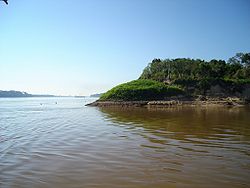Pando Department
|
Pando Department Departamento de Pando |
||
|---|---|---|

On the border between Brazil and Bolivia. The Madeira River is on the left, the Abunã River on the right.
|
||
|
||
| Motto: "Trabajo Industria Progreso" "Work, Industry, Progress" Anthem: Tierra santa, vestida de gloria Holy land, dressed in glory |
||
 Pando Department (red) within Bolivia. |
||
| Established | September 24, 1938 | |
| Named for | José Manuel Pando | |
| Capital | Cobijaa | |
| Provinces | 5 | |
| Government | ||
| • Prefect | Rafael Bandeira (interim) | |
| • Senators | Manuel Limachi Quispe (MAS) Mirtha Da Costa Ferreira (MAS) Roger Pinto Molina (PPB) Carmen E. Gonzales Lafuente (PPB) |
|
| • Deputies | 5 of 130 | |
| Area | ||
| • Total | 63,827 km2 (24,644 sq mi) | |
| Area rank | 5th in Bolivia | |
| 5.82% of Bolivia | ||
| Population (2012 census) | ||
| • Total | 110,436 | |
| • Density | 1.7/km2 (4.5/sq mi) | |
| • % of Bolivia | 0.7 | |
| • Rank | 9th in Bolivia | |
| Time zone | UTC-4 | |
| Area code(s) | +(591) 3 | |
| ISO 3166 code | BO-N | |
| Official language | Spanish | |
| Abbreviations | PA | |
| Website | www |
|
| a. Also largest city. | ||
Pando is a department of Bolivia, with an area of 63,827 square kilometres (24,644 sq mi), adjoining the border with Brazil and Perú. Pando has a population 110,436 (2012 census). Its capital is the city of Cobija.
The department, which is named after former president José Manuel Pando (1899–1905), is divided into five provinces.
Although Pando is rich in natural resources, the poverty level of its inhabitants is high, due largely to the lack of roads effectively linking the province to the rest of the country and the presence of tropical diseases, typical of life in the Amazonian rain forest. The main economic activities are agriculture, timber and cattle.
At an altitude of 280 metres above sea level in the northwestern jungle region, Pando is located in the rainiest part of Bolivia. Pando also has a hot climate, with temperatures commonly above 26 degrees Celsius (80 Fahrenheit).
Pando is the least populous department in Bolivia, the most tropical (lying closest to the Equator in the Amazonian Basin), and the most isolated, due to an absence of effective roads linking it to the rest of the country. It was organized at the beginning of the 20th century from what was left of the Acre Territory, lost to Brazil as a result of the so-called Acre War (1903). Its capital city of Cobija (the smallest of all the Bolivian departmental capitals) was named after the much-lamented Bolivian port of the same name on the Pacific Ocean, part of an area lost to Chile following the War of the Pacific.
Although backward and remote, Pando is densely forested and close to navigable waterways leading to the Amazon River and from there on to the Atlantic Ocean. The department underwent a rubber boom in the late 19th century and early 20th century, along with the northern part of nearby Beni department. The "boom," however, turned into a collapse of the rubber industry when synthetic rubber was discovered.
Culturally, the Pandinos are considered part of the so-called Camba culture of the Bolivian lowlands, similar to the people of the country's other two tropical departments, Beni and Santa Cruz. Many of Pando's original settlers moved from nearby Beni.
...
Wikipedia

